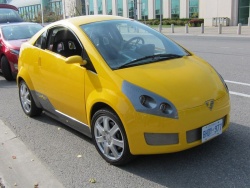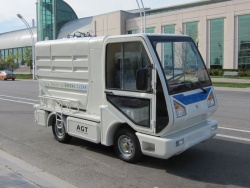 Project Eve, built from the ground up in Canada. Click image to enlarge |
Article and photos by Jil McIntosh
Photo Gallery:
EV 2011 Conference and Trade Show
Nothing to do with vehicles happens in a vacuum, but nowhere is that more evident than with the ongoing interest in electric vehicles. It’s not enough for automakers to simply put battery-powered motors into cars and trucks. There also has to be consideration for infrastructure, charging standardizations, safety, customer acceptance and ongoing technology, especially for their batteries.
All of these issues were part of the EV 2011 Conference and Trade Show, held in Toronto on September 26 to 28, 2011, and presented by Electric Mobility Canada, a national not-for-profit organization dedicated to the promotion of electric vehicles (http://www.emc-mec.ca/). It was primarily a series of conferences for the industry – it was a tough decision, but I turned down the opportunity to sit in on the no-doubt-riveting “Phosphate Coating for 5V Cathode Spinel LiMn1.5 NI0.5 O4” presentation – but on the opening day, media reps were invited to attend and take some gasoline-free test-drives. Alongside the now more familiar models sold by or upcoming from mainstream manufacturers, there was also a Canadian-built prototype and a Chinese-made electric truck.
  AGT low-speed electric truck (top), and its interior, with manual transmission. Click image to enlarge |
The big announcement at the conference was “Building Canada’s Green Highway,” a vision for Canadians to travel coast-to-coast using alternative energy to power their vehicles. The idea is to supplement the petroleum stations currently available with vehicle electricity and the accompanying infrastructure for charging. It is modeled on the West Coast Green Highway, a 2,172-km stretch of the I-5 interstate that uses a private-public partnership to focus on the need for alternative transportation methods and their infrastructure. Electric Mobility Canada is promoting the model to various levels of government in the hopes that it will turn into a concrete project.
The event took place on the grounds where Toronto’s Canadian National Exhibition is held each summer, in a repurposed building that was originally the Automotive Building for the annual fair. Parked outside were some of the current and future offerings: Smart Fortwo Electric, Chevrolet Volt, Ford Transit Connect Electric, Mitsubishi i-MiEV, Nissan Leaf, and Toyota Prius Plug-In Hybrid (PHEV). There was also Project Eve, a Canadian-built prototype, and a low-speed waste management truck from AGT Cars, a Chinese manufacturer, along with electric vehicle charging stations (EVSE) from Eaton and Schneider Electric.
There are many hurdles to overcome before electric cars go mass-market (if, in fact, they ever do). The car itself isn’t the difficulty; automakers nailed electric vehicles back in the late 19th century. In fact, electric cars were initially more popular than gasoline ones, at least until Cadillac invented a self-starter that eliminated the oft-difficult and dangerous job of cranking over a gas engine to start it. The major issue today is the battery, which hasn’t kept pace. Simply put, the more range a battery has, the more expensive, larger and heavier it is. Companies are working on newer, denser materials to squeeze more energy into smaller batteries, but it’s still a challenge.











